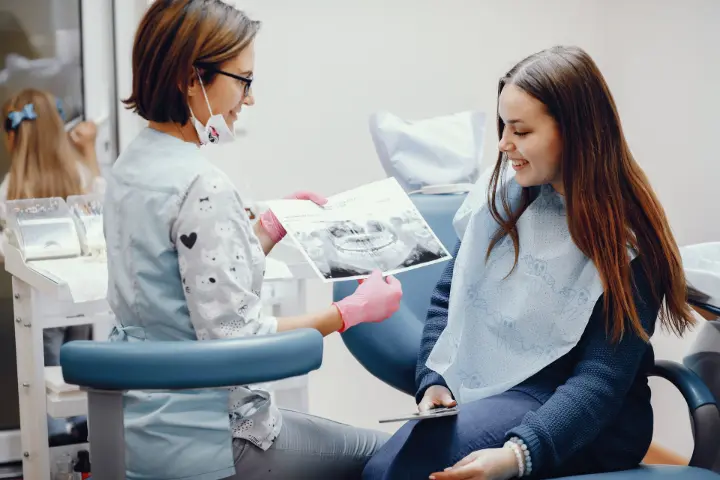When those two lines appear on a pregnancy test, a cascade of healthcare considerations begins—prenatal vitamins, obstetrician appointments, dietary adjustments, and lifestyle modifications. Yet amid this flurry of health-focused changes, dental care often remains overlooked despite mounting evidence of its significance during this transformative period.
At Vident Dental Clinic, we've guided countless expectant mothers through the nuances of pregnancy-related oral health. This comprehensive resource addresses the questions we hear most frequently in our practice, separating evidence-based recommendations from persistent misconceptions to help you maintain optimal dental health during this special time.
The Maternal Metamorphosis: How Pregnancy Transforms Your Oral Environment
The physiological revolution of pregnancy extends well beyond the obvious changes, creating a distinctly different oral environment that demands specialized attention.
The Hormonal Shift and Its Gingival Impact
The dramatic surge in estrogen and progesterone levels—increasing up to 10 times their non-pregnant levels—fundamentally alters how gum tissues respond to their environment:
- Enhanced vascular response: Pregnancy hormones increase blood flow to gingival tissues, creating the characteristic redness and tenderness many women notice as early as the first trimester
- Modified immune function: The delicate immunological balance of pregnancy affects how tissues respond to bacterial challenges, often amplifying inflammatory reactions to even minimal plaque accumulation
- Cellular alterations: Research published in the Journal of Clinical Periodontology demonstrates that pregnancy hormones modify fibroblast function and collagen maintenance in gum tissues, potentially reducing their resilience
These changes manifest in what clinicians recognize as "pregnancy gingivitis"—a condition affecting approximately two-thirds of expectant mothers, typically emerging around the second month and intensifying through the eighth month of pregnancy.
In some cases—approximately 0.5-9.6% of pregnancies—localized hyperplastic growths called "pregnancy granulomas" develop, usually on the anterior gingiva. Despite their sometimes alarming appearance, these tissue responses typically resolve spontaneously after delivery.
The Shifting Salivary Landscape
Pregnancy initiates subtle but significant changes to saliva that can influence cavity susceptibility:
- Compositional modifications: Hormonal fluctuations alter the protein content and enzyme activity in saliva, potentially reducing its natural protective functions
- Electrolyte variations: Changes in calcium and phosphate saturation may affect remineralization capacity
- Buffer capacity reduction: Some research indicates pregnancy may temporarily diminish saliva's ability to neutralize acids, creating a more cariogenic environment
A longitudinal study tracking salivary changes throughout pregnancy found that buffer capacity reached its lowest point during the third trimester—precisely when many women also experience increased carbohydrate consumption due to food preferences and eating patterns.
The Gastrointestinal Connection
The well-known digestive changes of pregnancy—from morning sickness to acid reflux—create direct challenges for dental health:
- Enamel vulnerability: Gastric acid exposure from vomiting or reflux can demineralize dental enamel, particularly on the lingual (tongue-side) surfaces of upper front teeth
- Behavioral impacts: Nausea may lead some women to avoid thorough brushing, particularly of posterior teeth, inadvertently increasing plaque accumulation
- Dietary adaptations: Crackers and small, frequent carbohydrate-rich meals—often recommended for nausea management—can increase caries risk when not balanced with appropriate oral hygiene
A clinical evaluation of women with hyperemesis gravidarum (severe pregnancy sickness) found measurable enamel erosion in 38% of cases, compared to just 11% in women with mild or no morning sickness.
Beyond the Mouth: The Systemic Connection Between Oral Health and Pregnancy Outcomes
Perhaps the most compelling reason for prioritizing dental care during pregnancy lies in the growing evidence linking maternal oral health status with pregnancy and birth outcomes.
The Inflammatory Pathway
Current research suggests that periodontal disease may influence pregnancy through inflammatory mechanisms:
- Systemic inflammation: Untreated periodontal disease creates a persistent inflammatory burden, releasing pro-inflammatory cytokines into circulation
- Placental impact: These inflammatory mediators may affect placental function and vascular development
- Potential triggers: In some cases, the inflammatory cascade may influence prostaglandin production and other factors involved in labor initiation
A 2022 systematic review analyzing data from over 15,000 pregnancies found that moderate to severe periodontal disease was associated with a 2.8-fold increased risk of preterm birth and a 2.3-fold increased risk of low birth weight, independent of other risk factors.
The Microbial Dimension
Beyond inflammation, research has examined direct microbial influences:
- Hematogenous spread: Periodontal pathogens can enter the bloodstream during routine activities like chewing or brushing
- Placental detection: Studies have identified oral bacteria in placental tissues and amniotic fluid, particularly in cases of pregnancy complications
- Fetal exposure: Evidence suggests potential direct exposure of the developing fetus to oral bacteria or their byproducts
A case-control study published in the European Journal of Obstetrics & Gynecology and Reproductive Biology found that women who experienced preterm birth were significantly more likely to have detectable levels of specific periodontal pathogens in their amniotic fluid compared to women with full-term deliveries.
The Vertical Transmission Consideration
The foundation for a child's future oral health begins before birth:
- Microbial seeding: A mother's oral microbial profile influences the initial colonization of her infant's oral cavity
- Caries susceptibility: Higher maternal levels of cariogenic bacteria correlate with earlier colonization and increased caries risk in children
- Behavioral modeling: Maternal attitudes toward oral health shape children's future dental habits
A fascinating longitudinal study tracking mother-child pairs found that children whose mothers had untreated decay during pregnancy were 3.5 times more likely to develop early childhood caries by age 36 months, even after controlling for socioeconomic factors and feeding practices.
Evidence-Based Clarity: Separating Dental Facts from Fiction During Pregnancy
Misinformation about dental care during pregnancy remains surprisingly prevalent, sometimes deterring women from seeking necessary treatment. Let's examine what the scientific evidence actually demonstrates:
Understanding Radiographic Safety
Concern about dental X-rays ranks among the most common reasons pregnant women avoid dental care:
Scientific Reality: Contemporary dental radiography poses negligible risk when appropriate precautions are taken.
- Modern digital sensors have reduced radiation exposure by 80-90% compared to traditional film
- A full mouth series of digital X-rays delivers approximately 0.01 millisieverts—less radiation than a day of natural background exposure
- Double shielding with both abdominal and thyroid protection further minimizes exposure
- The American Congress of Obstetricians and Gynecologists explicitly states that "diagnostic dental X-rays do not pose a hazard to the developing fetus"
While elective imaging may be postponed, diagnostic X-rays needed for treatment planning should not be avoided based on unfounded concerns.
The Anesthetic Evidence
Concerns about local anesthetics represent another common barrier to necessary treatment:
Scientific Reality: Dental anesthetics have established safety profiles during pregnancy.
- Lidocaine and other amide anesthetics are classified as Category B medications for pregnancy (no evidence of risk in humans)
- The minimal amounts used in dentistry do not approach levels of concern for fetal development
- Epinephrine in standard dental concentrations has not demonstrated adverse effects on uterine blood flow
- A comprehensive review in the Journal of the American Dental Association analyzing outcomes of over 5,000 dental procedures using local anesthesia during pregnancy found no association with adverse outcomes
Current guidelines from major health organizations support the use of local anesthetics when necessary for dental treatment throughout pregnancy.
Treatment Timing Considerations
Confusion about when dental treatment is appropriate during pregnancy remains common:
Scientific Reality: Necessary dental care is safe throughout pregnancy, though the second trimester often presents optimal conditions.
- First trimester: While organogenesis creates theoretical concerns, no evidence demonstrates risk from routine dental treatment; emergency care should never be delayed
- Second trimester: Generally considered ideal for elective procedures due to resolved morning sickness and reasonable patient comfort
- Third trimester: Primarily presents positional challenges rather than treatment contraindications; short appointments in semi-reclined positions accommodate patient comfort
A joint consensus statement from the American College of Obstetricians and Gynecologists and the American Dental Association emphasizes that "preventive, diagnostic, and restorative dental treatment is safe throughout pregnancy" and that "women should be counseled about the maintenance of good oral health habits throughout their lives as well as the safety and importance of oral health care during pregnancy."
The Calcium Myth
The notion that pregnancy "leaches calcium from teeth" persists despite lacking scientific basis:
Scientific Reality: Unlike bones, teeth do not serve as mineral reservoirs during pregnancy.
- Once formed, the mineral content of teeth remains stable during pregnancy
- The calcium needs of fetal development are met through dietary intake and maternal bone metabolism, not from dental structures
- Any observed tooth mobility during pregnancy typically relates to hormonal effects on the periodontal ligament, not calcium loss
This understanding highlights why adequate calcium intake during pregnancy benefits maternal bone health rather than "saving" teeth.
The Inevitability Misconception
Many women believe that dental problems during pregnancy are unavoidable:
Scientific Reality: While pregnancy increases susceptibility to certain conditions, proactive care can effectively prevent most issues.
- A controlled clinical trial demonstrated that pregnant women receiving monthly professional cleanings experienced 86% less gingivitis progression compared to those receiving only routine care
- Women implementing enhanced home care protocols showed significantly lower plaque levels despite hormonal changes
- Preventive measures including high-concentration fluoride applications reduced caries incidence in high-risk pregnant women by 76% in a 2023 interventional study
These findings emphasize that pregnancy-related dental changes respond well to appropriate preventive measures.
The Trimester-Specific Approach: Optimizing Dental Care Throughout Pregnancy
Different stages of pregnancy present unique considerations for dental care, warranting a tailored approach:
Preconception Optimization
Ideally, comprehensive dental care begins before conception:
- Thorough examination with complete radiographic assessment
- Resolution of active infection and disease
- Completion of extensive or complex treatment
- Establishment of effective preventive protocols
This proactive approach minimizes the need for extensive intervention during pregnancy.
First Trimester Navigation (Weeks 1-13)
During this critical developmental period:
- Communicate pregnancy status to your dental provider
- Address urgent issues promptly, particularly infections
- Implement enhanced home care routines focusing on gingival health
- Develop strategies for managing oral effects of morning sickness
- Consider postponing elective procedures when reasonable
While necessary treatment remains appropriate, many providers prefer to address only essential needs during this period of critical organ development.
Second Trimester Opportunity (Weeks 14-26)
This middle period typically offers optimal conditions for dental care:
- Schedule comprehensive preventive care including professional cleaning
- Address necessary restorative needs for active decay
- Manage emerging pregnancy gingivitis with targeted interventions
- Monitor and address any developing "pregnancy granulomas"
- Reinforce home care techniques as gingival sensitivity increases
With major organ systems formed and morning sickness typically resolved, this window provides both maximum safety and patient comfort for necessary procedures.
Third Trimester Adaptation (Weeks 27-Birth)
As delivery approaches, modifications help accommodate physical changes:
- Schedule shorter appointments to prevent positional discomfort
- Utilize modified semi-reclined positioning to prevent compression of major blood vessels
- Address only urgent or necessary treatment in late pregnancy
- Continue preventive care to maintain stability through delivery
- Prepare for postpartum care and infant oral health
After approximately 36 weeks, many providers postpone elective treatment until after delivery, though preventive care remains appropriate with positional accommodations.
Practical Protocols: Managing Pregnancy-Specific Dental Challenges
Beyond understanding the connections and timing, expectant mothers benefit from specific, actionable strategies for maintaining oral health during pregnancy.
Gingival Health Enhancement
Proactive measures can minimize hormonal effects on gum tissues:
- Technique refinement: Focus on sulcular (gumline) brushing using a 45-degree angle with ultra-soft bristles
- Interdental precision: Use appropriate-sized interdental brushes or floss picks if traditional flossing becomes difficult
- Anti-inflammatory rinses: Consider alcohol-free formulations containing chlorhexidine (by prescription) or cetylpyridinium chloride for short-term management of significant inflammation
- Professional intervention timing: Schedule professional cleanings at the beginning of the second and third trimesters, with additional appointments if inflammation progresses
- Nutritional support: Emphasize vitamin C, vitamin D, and omega-3 fatty acids, which support gingival health through anti-inflammatory mechanisms
Clinical studies demonstrate that pregnant women implementing enhanced gingival care protocols experience up to 60% less bleeding and inflammation compared to those maintaining only basic oral hygiene.
Erosion Prevention Strategies
For those experiencing morning sickness or reflux, these approaches help preserve enamel integrity:
- Neutralization protocol: Rinse immediately with a neutralizing solution (1 teaspoon baking soda in 250ml water) rather than plain water alone
- Brushing delay: Wait 60 minutes before brushing to allow remineralization of softened enamel
- Remineralization support: Apply calcium phosphate paste (available in various commercial products) to vulnerable surfaces
- Salivary stimulation: Use sugar-free, xylitol-containing gum to increase protective saliva flow
- Application technique: Apply high-fluoride products at night when salivary flow naturally decreases
A controlled intervention study found that pregnant women implementing these specific measures showed 73% less enamel erosion progression compared to those using standard oral hygiene approaches alone.
Strategic Nutritional Approaches
Pregnancy often brings dietary changes that may impact dental health:
- Cariogenic exposure timing: Consume sugary or acidic foods only with meals rather than as isolated snacks
- Protective food pairing: End meals with neutralizing foods like cheese or sugar-free yogurt
- Strategic hydration: Sip water consistently throughout the day, especially after eating
- Xylitol integration: Incorporate xylitol-sweetened products (5-6g daily distributed throughout the day) to reduce cariogenic bacterial levels
- Mindful supplementation: Choose sugar-free prenatal vitamins and calcium supplements when possible
These nutritional strategies help mitigate the potential dental impact of pregnancy-related dietary preferences and eating patterns.
The Vident Comprehensive Care Model for Expectant Mothers
At Vident Dental Clinic, we've developed a specialized approach to supporting pregnant patients through all stages of their journey:
Pregnancy-Focused Assessment
Upon learning of your pregnancy, we conduct a thorough evaluation designed specifically for expectant mothers:
- Comprehensive examination with minimal, targeted radiographs when necessary
- Detailed periodontal assessment focusing on early inflammatory signs
- Erosion and caries risk analysis incorporating pregnancy-specific factors
- Evaluation of existing restorations for potential stress-related complications
- Development of a trimester-specific treatment plan
This specialized assessment allows us to identify priorities and develop a personalized approach aligned with your pregnancy timeline.
Modified Treatment Protocols
Our pregnancy-specific clinical protocols include:
- Advanced digital radiography with ultra-sensitive sensors when imaging is necessary
- Carefully selected materials and medicaments reviewed for pregnancy safety
- Positional modifications including specialized cushioning for optimal comfort
- Appointment scheduling coordinated with periods of typical maternal wellbeing
- Emergency care availability with obstetrician consultation when appropriate
These adaptations ensure both safety and comfort throughout your pregnancy while addressing necessary treatment needs.
Enhanced Preventive Programming
We emphasize prevention to minimize interventional needs:
- Personalized home care instruction addressing your specific pregnancy-related challenges
- Professional application of remineralizing agents for high-risk patients
- Targeted antimicrobial therapy for those with significant gingival inflammation
- Customized product recommendations based on individual risk assessment
- Early intervention for emerging issues before they require extensive treatment
This preventive emphasis helps maintain optimal oral health while minimizing the need for complex procedures during pregnancy.
Continuity Through the Maternal Journey
Our care extends beyond pregnancy to support the transition to parenthood:
- Scheduling of postponed treatment at appropriate intervals after delivery
- Guidance on infant oral hygiene beginning from the first weeks of life
- Education about preventing early childhood caries through appropriate feeding and cleaning practices
- Planning for your child's first dental visit by the first birthday
- Ongoing support for maternal oral health during the demanding postpartum period
This continuous care model recognizes that maternal oral health remains important well beyond delivery and influences the dental future of the next generation.
Conclusion: A Foundation for Two Smiles
Pregnancy represents not just a critical period for your overall health but also a unique window for establishing the foundation of your child's future oral health. By understanding the bidirectional relationship between oral health and pregnancy, implementing appropriate care strategies, and working with dental professionals experienced in prenatal care, expectant mothers can maintain excellent oral health while potentially improving pregnancy outcomes.
At Vident Dental Clinic, we're committed to supporting you through this transformative time with evidence-based care that addresses your unique needs as an expectant mother. We invite you to schedule a pregnancy dental assessment to develop a personalized care plan that supports both your health and your baby's development.
Remember that in prioritizing your oral health during pregnancy, you're making an investment that benefits two smiles—yours and your child's.
This article provides educational information about dental care during pregnancy. For personalized recommendations, please schedule a consultation with our dental team at Vident Dental Clinic.



